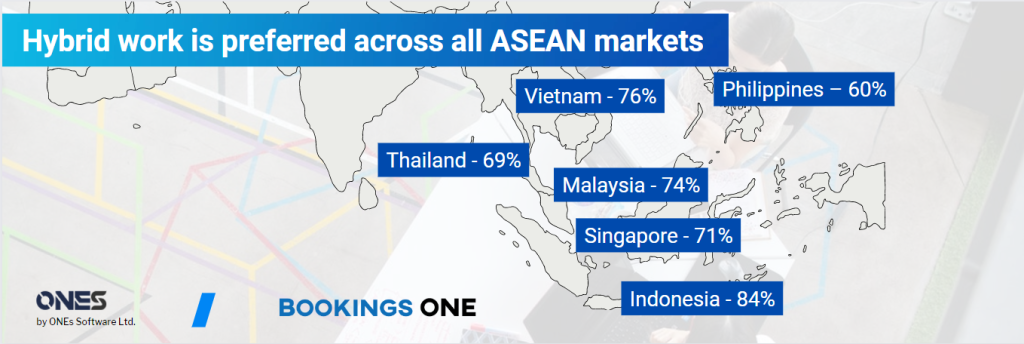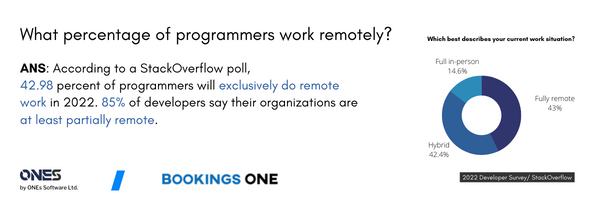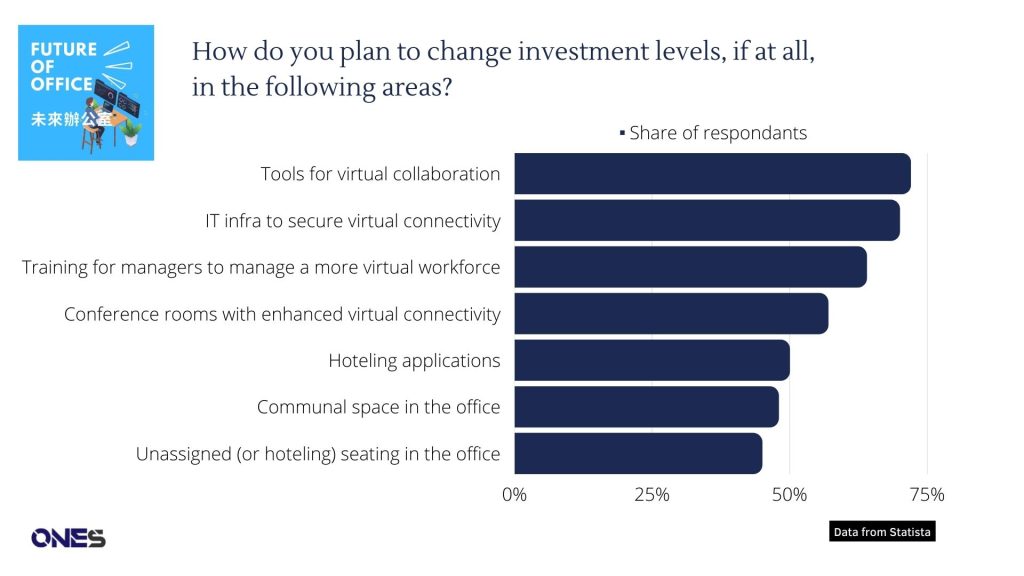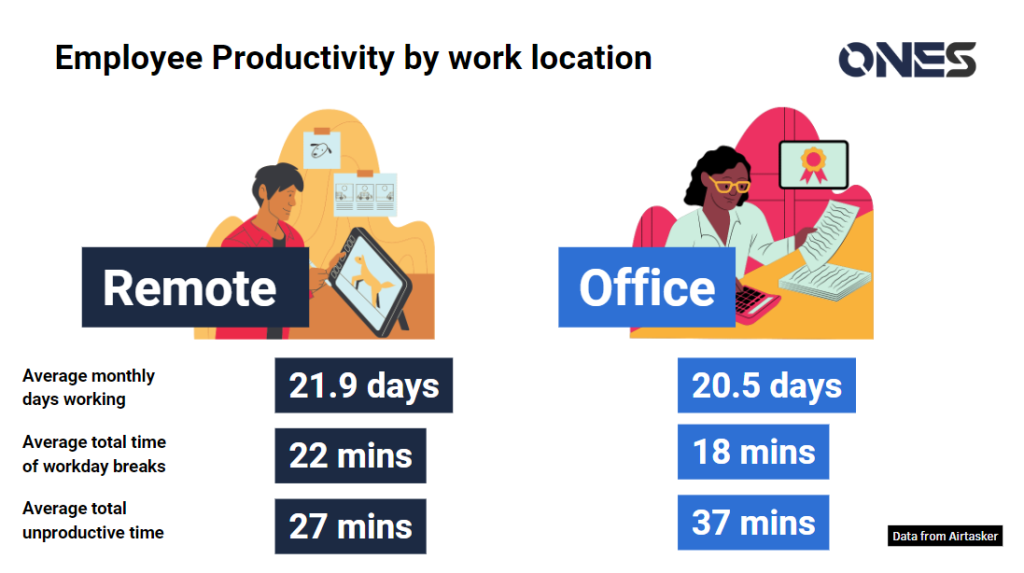If the workspace business could be summarized in a single sentence in 2022, it would most likely be “hybrid working.”
Hybrid working is an arrangement in which a company’s management and employees alternate between working in a physical office and working remotely. The transformation is now evolving as many firms adopt hybrid working practices to accommodate an increasingly digital-based workforce.
By Gallup’s recent survey, remote work flexibility appears to be quickly becoming a permanent feature of the workweek for most employees working remote-capable jobs, with nine out of ten preferring some degree of long-term remote flexibility in the future and nearly eight out of ten expecting it from their employer.
Given this shift in where and how remote-capable people work, the next key question is how to best arrange hybrid work schedules with employees who split their time between remote and office environments.
Table of Contents
Expectations of Hybrid Work
Hybrid work expectations include:
- Employees have quick and secure access to business resources from wherever they are, including seamless transitions into and out of the office network and access to local and cloud resources.
- Being able to use any device (a personal iPhone or iPad or a professional laptop) from any location – home, work, a coffee shop, or an aircraft — while knowing that security controls would be in place.
- Less (or no) commute time and no friction when asking for resources to execute their work successfully.
General Statistics
General hybrid working trend
Gartner predicts that by the end of 2023, 39% of global knowledge workers will be working in a hybrid model that combines remote and office-based work.
This is a significant increase from pre-pandemic levels and is being driven by a variety of factors such as employee preferences, cost savings for companies, and the need for greater flexibility and work-life balance.
“For remote-first or hybrid organizations, fully mature virtual workspaces may replace the office as the embodiment of company culture and become the center of the digital employee experience,” said Christopher Trueman, Senior Principal Analyst at Gartner.
“However, employees should not be expected to engage in the virtual workspace for their entire workday. Virtual workspaces should only be used for meetings and interactions that will be enhanced by them, such as brainstorming, product reviews, or social gatherings.”
(Gartner)
More than 70% of employees are working from home at least two to three days a week.
This is an increase over the previous year’s EY Index, which indicated that just roughly 42% of firms used a mixed strategy. New and complex work patterns significantly impact a company’s real estate strategy, including the quantity of office space needed and the cost of using that space.
Almost 60% use, or plan to use, reservation systems for space usage and/or occupancy tracking.
(EY)
“Work-from-anywhere” is the new reality
By IWG trends forecast for 2023, work from anywhere is rapidly becoming the norm, and companies that embrace this trend are likely to see significant benefits.

- 70% of professionals work remotely at least once a week, and 53% work remotely for at least half the week.
- By 2025, an estimated 1.87 billion people will be working remotely.
- Remote workers are more productive and report better work-life balance than office-based workers. A remarkable 98% of managers said they’re confident in their teams’ ability to deliver results on non-office days, by the FlexOS report.
- Work from anywhere is becoming a key factor for job seekers, with 70% saying it’s important when considering a new role.
- Companies that embrace work from anywhere see benefits such as increased productivity, reduced real estate costs, and access to a wider talent pool.
- Technology is a crucial enabler of work from anywhere, with tools like video conferencing, collaboration software, and cloud-based platforms facilitating remote work.
Hybrid work is preferred across ASEAN markets

The Cisco study highlighted many employees across ASEAN markets now prefer that hybrid work:
- Singapore – 71%
- Malaysia – 74%
- Indonesia – 84%
- Vietnam – 76%
- Thailand – 69%
- The Philippines – 60%
The support for hybrid work extends beyond employees as well — with 90% of employees saying their employers have been supportive of hybrid working.
In particular, 46% said their employers have been supportive, while 44% said their employers have been very supportive.
(Cisco)
Employees’ preferred work modes in APAC
In a 2022 survey conducted among employees in the Asia-Pacific region, a majority of 66 percent of the respondents stated they would prefer to work in hybrid mode in the future.
In contrast, only ten percent of the respondents preferred in-person work.
(statists)
The implementation of financial services firms
Studies show that 80% of financial services firms now have hybrid work models in place, with some allowing full flexibility and others requiring 2-3 days per week in the office.
The studies also found that only 20% of financial services companies require full-time on-site work. Instead, the majority (80%) offer hybrid or remote options.
These companies are roughly split between being fully flexible (39%), with no set on-site requirements, or having a structured hybrid model (41%), requiring 2-3 set on-site days per week.
Hybrid and remote models are more common in FinTech companies and smaller firms, and prevalence varies based on location and industry sector. The survey shows flexible work is becoming the norm even in traditionally office-centered industries like finance.
The expectation of employers should remain flexible about hybrid working
Based on the voting made by Financial Times, more than 70% of people expect employers should remain flexible about hybrid working.
(Source)
The expectation of the number of days worked on-site per week
Hybrid workers vary widely in how many days they typically work from the office:
- one-third are on-site one day per week
- one-third are on-site two to three days per week
- one-third are on-site four days per week
Preferences for time spent on-site also widely vary with the nuance that very few want to work on-site four or more days per week:
- Only 12% of hybrid employees want to spend four or five days on-site in the typical week.
- Of the 88% of hybrid workers who prefer three days or fewer on-site, slightly more prefer two days on-site (29%) compared with one (19%) or three (22%) days on-site.
(Gallup)
Most Preferred Hybrid Schedule: Working On-Site Two Days Per Week
Fridays and Mondays are the least popular days to be on-site both in terms of voluntary attendance and employer-required days on-site.
- The daily mood shift from Sunday to Monday is the starkest in Gallup’s historical tracking. So it’s no surprise that Monday is a less popular day to be on-site than Tuesday through Thursday.
- In contrast, Fridays are decisively the most popular day to work from home so employees can focus on wrapping up their work assignments and quickly transition to their weekend plans.
Tuesday through Thursday are the days of the week hybrid employees work on-site most often and are also the days when on-site work is most likely to be required by employers.
(Gallup)
Percent of Engaged Workers by Number of Days On-Site
Three of the most common hybrid policies are:
- 29% say their employer requires office attendance on specific days of the week (e.g., Tuesday through Thursday)
- 28% say their employer requires a minimum number of days on-site (e.g., one to four days per week), but doesn’t specify which days are required
- 43% say there are no universal on-site work requirements set by the employer
Employer requirements:
- 57% of hybrid employees say their employer sets office attendance rules — about half of those with attendance rules are required to be on-site a specific number of days and half are required to be on-site on specific days of the week (i.e., Tuesday through Thursday)
- 43% of employees report that their employer does not require a minimum number of days on-site
The most preferred and the most engaging policy:
- Many hybrid workers (60%) do not want their employer to set a universal scheduling policy.
- Employee engagement is highest among hybrid workers when their company does not require a certain number of days on-site.
(Gallup)
Benefits of working remotely
In 2022, the main benefit of remote work worldwide was the ability to have a flexible schedule with 67 percent of respondents naming it as the biggest benefit of working remotely. The flexibility to work from any location ranked second.
(statista)
Employee happiness and morale (60%) are cited as important benefits of remote work by managers, along with reduced commuting time and stress (54%), enhanced work-life balance (53%), increased productivity (35%), and an enlarged talent pool (30%).
(FlexOS)
Reasons People Seek Flexible Work
Research by McKinsey & Co.
By McKinsey & Co. survey, 52% of people prefer a hybrid working model after the pandemic, while only 30% of people expect that pre-pandemic.
Research by FlexJobs
Also, an annual survey made by FlexJobs shows that 80% of employees prefer to work more flexibly, which will also increase their loyalty to the company because of remote working.
Work-life balance (75%):
-They have more flexibility to take a better balance between their work and their lives; therefore, they can decide the spend more time enjoying their life.
Family (45%):
-They have more time to stay with their family members, even during working hours.
Time savings (42%):
-|They can save time for travel to the workspace and more time to rest.
Commute stress (41%):
–Remote work allows them to work on their own terms and out of the constant supervision of their supervisors, therefore they can work with much less stress.
(FlexJobs)
Research by Ergotron
One thousand full-time employees were sampled for Ergotron research. It was discovered that the hybrid workplace model has given employees the power to recover their physical health, and they are also experiencing benefits for their mental health as workers become more accustomed to hybrid and remote office environments since the start of Covid-19.
Overall, 56% of workers mentioned increased physical exercise, better work-life balance, and improved mental health.
“Promoting health and wellness among employees can improve well-being and productivity,” said Chad Severson, CEO of Ergotron.
“Over the past two years, employees have adapted to the hybrid and remote work landscape—and they now prefer it. As employers look to attract and retain talent, focusing on practices that promote well-being and help employees thrive wherever they work will be critical.”
- Job Satisfaction. It’s crucial to keep practicing flexibility. The majority of workers (88%) concur that having the option to work from home or the office has improved their level of job satisfaction.
- Physical health. The hybrid workplace has given workers the power to regain their physical well-being. 75% of respondents said that when they work remotely, they move about more and engage in more active work.
- Work-life balance. According to 75% of respondents, remote or hybrid working has improved their work-life balance.
Even though some employees are spending more time at work, they claim that a better work-life balance has a favorable impact on their ability to balance work with other facets of their lives. - Comfortable work environments. Improved workspaces with ergonomic furniture are crucial and boost corporate culture, according to 62% of the workers questioned.
(Ergotron)
Current and Anticipated Employee Work Locations for Remote-Capable Jobs
Prior to the pandemic, just 8% of remote-capable employees worked entirely from home, with around one-third having a mixed work arrangement.
Then the epidemic struck, forcing the great majority of remote-capable individuals to work from home in some form – as many as 70% worked entirely from home in May 2020.
Time travel to February 2022. Most remote-capable employees continued to work from home at least part of the time, but the divide remained virtually even: 42% maintained a hybrid schedule, and 39% worked totally from home.
(Gallup)
Estimated Remote Workforce by Industry
According to survey respondents, the average percentage of employees working remotely prior to COVID was only 16%.
Since then, that number has increased to 65%, with the majority of workers in the professional services (89%), information technology (88%), and financial services and insurance (74%) sectors working from their dining tables.
Percentage of people in America who work remotely full time
Nearly two years into the COVID-19 pandemic, roughly six-in-ten (59%) of U.S. workers say their jobs can primarily be done from home work from home all or most of the time. According to a new Pew Research Center survey, the vast majority of these workers (83%) were working from home before the omicron variant spread in the United States.
Percentage of U.S. work teams/departments that plan to work remotely in 5 years with comparison to pre-pandemic
“More than 20% of the workforce could work remotely three to five days a week as effectively as they could if working from an office. If remote work took hold at that level, that would mean 3 to 4 times as many people working from home than pre-pandemic and a profound impact on urban economies, transportation and consumer spending, among other things.” — “What’s Next for Remote Work”, McKinsey & Company, November 23, 2020
(weforum)
Frequency of working from home before the coronavirus pandemic in APAC
In a survey conducted in October 2020, prior to the implementation of remote work due to the coronavirus pandemic, 36% of respondents from the Asia-Pacific area claimed to work from home at least once each week.
(Statists)
WFH Frequency – Before and Post COVID-19
In the Stantec survey, 90% of respondents said they work from home more than four days each week. Before any North American government issued orders to stay at home, Stantec required remote work for all of its employees.
In a week, more than 19,000 workers had to switch to remote work in order to protect our staff and stop the virus’ spread.
The fact that more people are choosing to continue working from home after the epidemic may not come as a surprise to you. The typical respondent may work from home an extra day per week compared to their pre-COVID-19 habit, based on the self-reported frequencies in our survey.
(Stantec)
Remote Work Saves Commuting Time
Americans who are working from home have reclaimed 60 million hours, e.g. around 68,447 years, which means each American can saves 1.8 hours per day that used to spend commuting to an office each day.
They’re now using that time to get more sleep instead.
Hybrid Workers Will Change Jobs for Flexibility, but Won’t Give Up Salary
Remote flexibility has become the norm. Remote-capable employees are willing to change jobs for it, but they are unwilling to give up more money in exchange.
More than 56% of remote capable employees will not give up any percentage of their salary for work location flexibility.
(Gallup)
Remote Teams Are More Engaged Than Office Workers
Remote workers consistently meet and exceed objectives, identify new processes, and contribute to company culture in the same way that anyone in a traditional brick-and-mortar setting does. In fact, they tend to achieve more.
According to a Stanford University two-year research, remote employees are, on average,
- 13.5% more productive than their office-based counterparts.
- 9% more engaged in their jobs.
- 50% less likely to quit.

People movement
People movement in the U.S.
Some people have left city centers (e.g. NY and SF) from Feb 2022-Jul 2021.
Global workers’ mindset concerning hybrid work 2021, by category
In 2021, 42 percent of workers expect to thrive in hybrid employment. This demonstrates that over half of the worldwide workforce has an optimistic outlook on the future of work. Notably, 31% of respondents report feeling dissatisfied in this situation. (Statista)
Different generations’ expectations of hybrid working
It may be challenging to find a hybrid model that works for all generations: Three-quarters of Gen Zers (74%) desire more face-to-face collaboration chances, compared to 66% of Gen Xers and 66% of Baby Boomers. (Intuition)
High-growth businesses plan on hybrid working
63% of high-growth businesses use hybrid work models. (Intuition)
The percentage of people who plan to work from home
One survey found that 92 percent of those asked to plan to work from home at least once a week, and 80 percent expect to work from home at least three times a week. (Intuition)
The percentage of the programmer who is practicing hybrid working
85% of developers say their organizations are at least partially remote. (42.98% fully remote, 42.44% hybrid working)
Smaller organizations are most likely to be in-person, with 20% of 2-19 employee organizations in-person.
The percentage of programmers who expects hybrid working after the pandemic

47.6% of developers said they expect to work in a hybrid model after the pandemic, while 38.8% said they expect to do fully remote work.
Main challenges in working a mix of remote and in-person worldwide
In 2022, 43 percent of remote employees reported that the most difficult aspect of working remotely and in person was not feeling involved in meetings. (Statista)
For remote leaders’ largest remote work challenges, they answered distractions at home (46%), a lack of face-to-face interactions (37%), and technological or connectivity issues (33%.)
(FlexOS)
Favorite hybrid arrangement
Four out of ten employees say they want complete autonomy to come and go as they choose, while six out of ten want more structure.
There is even less agreement among those six in ten on how to synchronize in-person and remote schedules, with less than a third agreeing on how to define hybrid for their business.
Employee preferences and the appropriateness of hybrid work schedules vary greatly depending on the organization, team, role, and individual. There is no one-size-fits-all solution. What matters is that leaders assess which kind of guidelines work best for their team, given the sort of work they perform, the level of assistance required, and the team culture.
(Gallup)
Number of days per week they come to the office
Four out of every ten employees want to work two to three days each week, although this is far from the majority. Another three out of ten employees would like to spend one or two days per week in the office.
On the plus side, most employees think that spending a reasonable amount of time at work is crucial, and Gallup’s research has consistently shown that work flexibility is optimum for engaging employees and preventing burnout – both before and after the epidemic.
Nonetheless, as organizations shift and adjust to hybrid work, employees’ preferences for office hours will be a crucial measure to monitor.
(Gallup)
Suburban commuters’ transit behavior
People who reside in suburbs and commute to cities experience the highest decline in transit trips (-24%). Consequently, it is likely that respondents who have lengthier transit commutes and other local transportation options will reduce their use of public transportation the most.
People who live in suburbs and work in cities were shown to have the largest increase in working from home (an increase of 3.7 days per month per person). It appears that working from home could replace longer commutes.
According to what we overheard, respondents who reside and work in suburban areas had the least amount of change in all behavioral categories.
This means that metropolitan regions and areas nearby are where most long-term change is expected to take place.
(stantec)
Statistics for Business Leaders
Hybrid work policy decision-makers and their impact on employee engagement
Required attendance policies for hybrid workers are decided by:
- top leadership of the organization (26%)
- team managers (24%)
- work teams (13%)
- entirely on my own (37%)
The most engaging approach is the least common:
- An astounding 46% of hybrid employees are engaged at work when their team determines their hybrid work policy — despite only 13% of employees saying their team does this.
- Employee input is notoriously effective, from collaborative goal setting to innovation — and now in determining hybrid work schedules.
- The practice of asking team members to collaboratively craft their hybrid work policy is one of the most engaging single work practices Gallup has studied among employees who are returning to the office.
(Gallup)
Lots of executives believe flexible working options motivate employees
Sixty-four percent of CEOs feel that flexible work arrangements stimulate their personnel.
Flexibility and technology in the workplace are important priorities. To improve the workplace, most are considering the usage of health and wellness management applications as well as other hybrid work technologies such as digital and virtual collaboration resources.
For example, 44% of company leaders have activated or are about to activate the metaverse for social interaction, training, and/or recruiting purposes, and 62% have activated or are about to activate health and safety innovations and monitoring, such as indoor air quality, touchless offices, and so on.
(EY)
Women leaders expect more flexibility

49% of women leaders say flexibility is one of the top three things they consider when deciding whether to join or stay with a company, compared to 34% of men leaders.
Women leaders are more than 1.5x as likely as men at their level to have left a previous job because they wanted to work for a company that was more committed to DEI.
Additional technological transformation due to pandemic
Based on Fortune surveying CEOs of the Fortune 500, the pandemic crisis, according to 75% of respondents, will push their companies’ technology transformations forward more quickly.
(Fortune)
Top challenges executives expect to navigate
Executives are prepared for a range of employee reluctances. Top worries include worries about health and safety (40%), caregiving responsibilities (38%), and taking public transportation (20%).
CEO expectation on the percentage of workforce return office
Based on Fortune surveying CEOS of the 2020 fortune 500 list, 26.2 % of CEO expect the percentage of their workforce that return to their usual workplace will never reach back to 90%.
(Fortune)
CEO expectation for the benefits of return office
Collaboration (45%) and camaraderie and morale (61%) are the top two ways executives anticipate that going back to work would enhance corporate culture.
Workers’ willingness to pursue a hybrid working paradigm is higher among C-suite others than among employees in the United States in 2021
Office occupations have become more flexible since the onset of the coronavirus (COVID-19) outbreak. Working from home has been the norm for many, yet office spaces continue to be popular.
Employees who operate in a hybrid mode might divide their time between the workplace, home, and other locations. According to a 2021 study of 1,000 office employees and 1,000 C-suite employees in the United States, the clear majority of respondents support the hybrid approach.
Meanwhile, a larger proportion (79 percent) of C-suite personnel planned to implement the hybrid approach. According to the same study, over half of respondents would prefer to spend two to four days at work.
(Statista)
C-suite executives plan on hybrid working
In the post-pandemic future of work, nine out of ten organizations will be combining remote and on-site working.
(McKinsey – From December 2020 through January 2021, McKinsey surveyed and analyzed responses from 100 respondents at the C-suite, vice-president, and director level, evenly split among organizations based in Asia, Europe, Latin America, and the United States, and among a variety of industries. Company revenues ranged, on average, from $5.1 billion to $11.0 billion per year.)
C-suite executives’ expectations of hybrid working
The majority of CEOs anticipate that employees will be on-site between 21 and 80 percent of the time, or one to four days a week (for all roles that are not required to be performed on-site). (McKinsey)
Plan of fully remote work vs support hybrid work model
According to a recent survey, just 5% of employers see entirely remote work as a possibility in the future, while 51% prefer the mixed work style. (Intuition)
Pay adjustment for hybrid work model
Over 97 percent of firms said they will not lower compensation for workers who work from home in part. However, 21% would modify pay based on an employee’s contribution and physical location. (Intuition)
Plan to adjust investment levels in the hybrid work model

According to a recent poll, 72 percent of respondents in the United States want to invest in virtual collaboration technologies in the future to support their mixed workforce. Zoom, Microsoft Teams, and Miro are examples of virtual collaboration software. These tools enable remote employees to stay connected while working from multiple places.
| Tools for virtual collaboration | 72% |
| IT infra to secure virtual connectivity | 70% |
| Training for managers to manage a more virtual workforce | 64% |
| Conference rooms with enhanced virtual connectivity | 57% |
| Hoteling applications | 50% |
| Conference rooms with enhanced virtual connectivity | 48% |
| Unassigned (or hoteling) seating in the office | 45% |
(Statista)

Learning Statistics in a Hybrid World
Advice offered to those selecting a remote work location
Setting limits is the most essential objective for 25% of respondents in a recent study, more than any other conceivable response. This is especially important as burnouts become more common, and balancing private and professional lives is a method to sustain mental health and productivity.
(Statista)
Acquired technologies to safeguard work communications when working from home in 2021
In 2021, 34% of Android and IOS users reported purchasing a WiFi router to safeguard work communications while working from home during the pandemic. Virtual private networks came in second. Mobile applications and mobile device management software are two more technologies utilized for this purpose.
(Statista)
The willingness to Online Learning
57 percent of today’s learning and development professionals anticipate increasing their spending on online learning in the near future.
In a hybrid environment, online learning is frequently given via mobile, with 70 percent of modern-day firms delivering courses via this media.
Health and Wellness Statistics
One thousand full-time employees were sampled for Ergotron research. It was discovered that the hybrid workplace model has given employees the power to recover their physical health, and they are also experiencing benefits for their mental health as workers become more accustomed to hybrid and remote office environments since the start of Covid-19.
Overall, 56% of workers mentioned increased physical exercise, better work-life balance, and improved mental health.
(Ergotron)
Work-life balance
During the pandemic, 20% of worldwide employees asked stated their supervisor had ceased caring about their work-life balance, leaving 54 percent overworked and 39 percent absolutely fatigued.
Productivity
As the hybrid workplace emerges, 40% of individuals feel they can be productive and healthy from anywhere – whether entirely remote, onsite, or a mix of the two.

Remote employees worked 1.4 more days per month, or 16.8 more days per year, on average than those who worked in an office. And they spent more time getting things done on those workdays.
While office workers reported losing an average of 37 minutes per workday to distractions (excluding lunch and standard breaks), remote employees only lost 27 minutes per workday. While remote workers did take more official breaks than office workers, evidence shows that taking breaks leads to higher rates of productivity.
There were only minor differences in the ability to concentrate or focus in and out of the office: 8% of remote workers reported difficulty focusing, compared to 6% of office workers.
Micromanagement, on the other hand, had a significant impact. When employees’ screen and/or mouse time was tracked, 39% of remote employees and 56% of office employees found ways to avoid working. They didn’t always get away with it: 51% of remote employees and 44% of office employees were caught.

On the other hand, 66% of managers reported greater productivity, with 48.5% reporting that productivity has ‘significantly improved.’ Only 2% experienced a decline in productivity.
Managers said that their personal productivity has increased (38%) but not reduced (96%).
(FlexOS)
Mental health support
Employee burnout is now a serious problem, with 75% of workers in recent research wishing their workplace provided some type of mental health assistance.
Feared being surveilled
According to a Capgemini analysis on the future of remote working, around 66 percent of employees in the United States worried about being surveilled by the use of technology when remote working in 2020, which is higher than the global average of 59 percent.
Struggles with working remotely
In 2022, 25% of respondents stated that the most difficult aspect of working remotely was not being able to unplug. Because many individuals who work from home do not have a distinct office, they have a conflation of their living environment and workplace. However, more than one-third of respondents said they had no difficulties working remotely.
As a result, remote working professionals underline the significance of developing techniques to balance their personal and professional life. On the other hand, employees report fewer challenges with teamwork and communication in 2021.
This is most likely owing to the rapid development of skills during the 2020 pandemic, which allows them to successfully communicate and interact with others while working from different locations.
(Statista)
Terms you should know
Diversity, Equity, and Inclusion (DEI)
DEI stands for diversity, equity and inclusion.
As a discipline, DEI is any policy or practice designed to make people of various backgrounds feel welcome and ensure they have support to perform to the fullest of their abilities in the workplace.
Diversity refers to the presence of differences within a given setting; in the workplace, that may mean differences in race, ethnicity, gender, gender identity, sexual orientation, age, and socioeconomic background.
Equity is the act of ensuring that processes and programs are impartial, fair and provide equal possible outcomes for every individual.
Inclusion is the practice of making people feel a sense of belonging at work.
(builtin)
Digital nomad
A digital nomad is a person who has the freedom to work from anywhere in the world as long as they have an internet connection and a laptop or mobile device.
Digital nomads leverage technology to create a location-independent lifestyle, allowing them to travel and work remotely. This lifestyle can involve working from home, coffee shops, co-working spaces, or even exotic locations abroad.
Digital nomads are often freelancers, entrepreneurs, or employees of companies that allow remote work. They may work in a variety of fields, such as writing, programming, design, or consulting.
The rise of digital nomadism has been facilitated by the increasing availability of digital tools that enable remote work, as well as the growing popularity of the gig economy.
Many people are drawn to the digital nomad lifestyle for its flexibility, adventure, and opportunities for personal growth. Digital nomads can experience different cultures, meet new people, and have unique experiences while maintaining their careers.
They also have the ability to work on their own terms, choose their own projects, and have more control over their work-life balance.
Further reading on Hybrid working
Treating Remote Employees Fairly in a Hybrid Workplace (by Toptal)
Learn more about productivity in the hybrid working era: https://ones.software/blog/?s=Productivity+
Develop your own hybrid office with our smart office system: https://ones.software/


